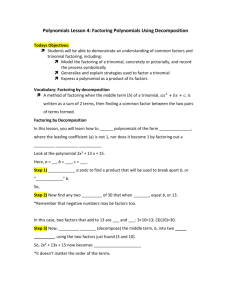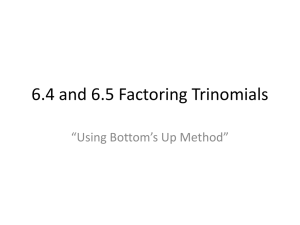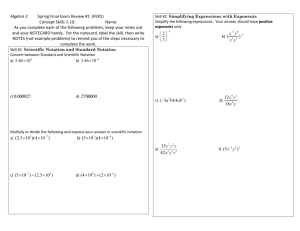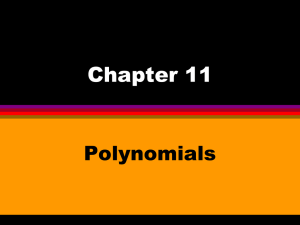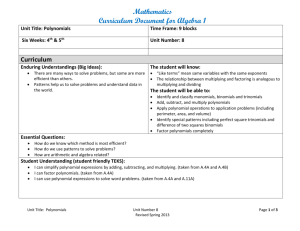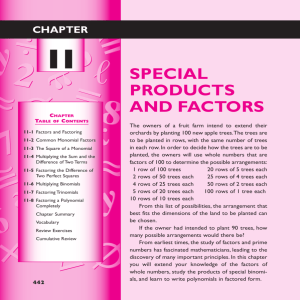Chapter 5 Guideline on Polynomials, Factoring, and Multiplying
advertisement
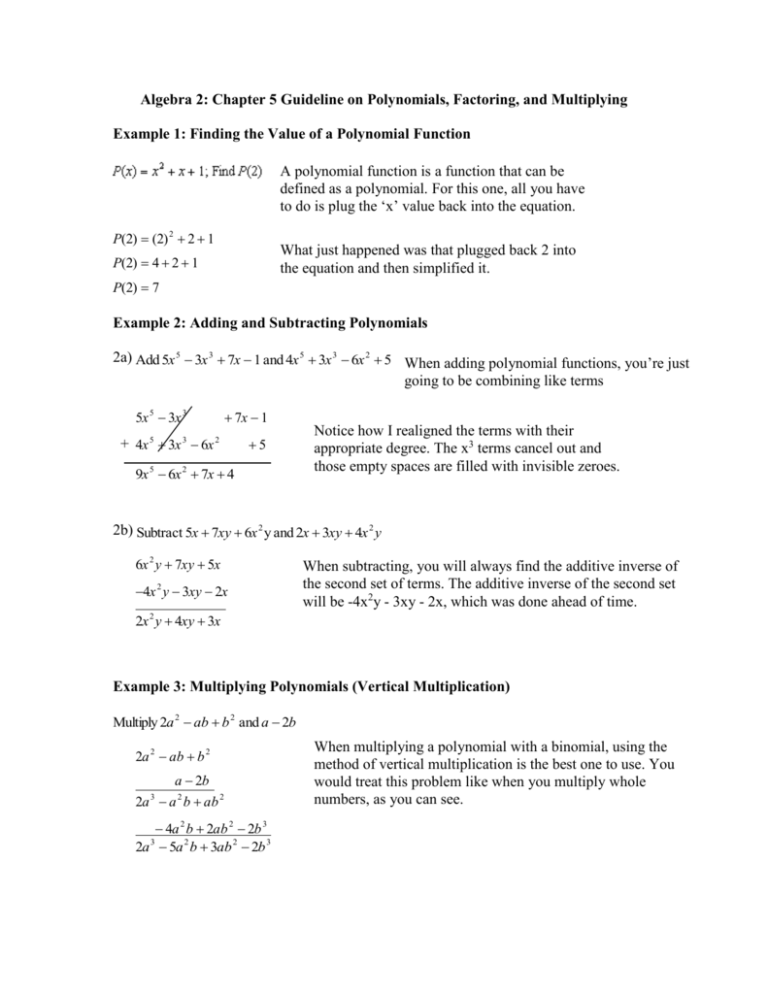
Algebra 2: Chapter 5 Guideline on Polynomials, Factoring, and Multiplying Example 1: Finding the Value of a Polynomial Function A polynomial function is a function that can be defined as a polynomial. For this one, all you have to do is plug the ‘x’ value back into the equation. P(2) (2) 2 2 1 What just happened was that plugged back 2 into the equation and then simplified it. P(2) 4 2 1 P(2) 7 Example 2: Adding and Subtracting Polynomials 2a) Add 5x 5 3x 3 7x 1 and 4x 5 3x 3 6x 2 5 When adding polynomial functions, you’re just going to be combining like terms 5x 5 3x 3 7x 1 + 4x 5 3x 3 6x 2 5 9x 5 6x 2 7x 4 Notice how I realigned the terms with their appropriate degree. The x3 terms cancel out and those empty spaces are filled with invisible zeroes. 2b) Subtract 5x 7xy 6x 2 y and 2x 3xy 4x 2 y 6x 2 y 7xy 5x 4x 2 y 3xy 2x When subtracting, you will always find the additive inverse of the second set of terms. The additive inverse of the second set will be -4x2y - 3xy - 2x, which was done ahead of time. 2x 2 y 4xy 3x Example 3: Multiplying Polynomials (Vertical Multiplication) Multiply 2a 2 ab b 2 and a 2b 2a 2 ab b 2 a 2b 2a a 2 b ab 2 3 4a 2 b 2ab 2 2b 3 2a 3 5a 2 b 3ab 2 2b 3 When multiplying a polynomial with a binomial, using the method of vertical multiplication is the best one to use. You would treat this problem like when you multiply whole numbers, as you can see. Example 4: Methods to Multiply Binomials 4a) The F.O.I.L. Method O F (A B)(C D) AC AD BC BD The F.O.I.L method is used commonly when you have four unlike terms. Before, students were only taught to use this method for all types of binomials even those with same two terms ‘A’ and ‘B’. I L (3x 2y)(5x y) (3x)(5x) (3x)(y) (2y)(5x) (2y)(y) 15x 2 3xy 10xy 2y 2 15x 2 13xy 2y 2 4b) Square of Binomials The square of a binomial is the square of the first expression, plus or minus twice the produce of the expressions, plus the square of the second expression. (A B) 2 (A B) 2 A 2 2AB B 2 A 2 2AB B 2 (x 4) 2 (2x 3) 2 (x) 2 2(4)(x) (4) 2 (2x) 2 2(3)(2x) (3) 2 x 2 8x 16 4x 2 12x 9 *Pay attention to the “skeletons” of each equation. The only difference between the formulas is the operation used in the second term of the equation. 4c) Sum and Difference The product of the sum and difference of two expressions is the square of the first expression minus the square of the second. (A B)(A B) A 2 B 2 (x 6)(x 6) (3x 4y)(3x 4y) (x) 2 (6) 2 (3x) 2 (4y) 2 x 2 36 9x 2 16y 2 4d) Cubing Binomials The cube of a binomial is the cube of the first expression, plus or minus three times the product of the first expression squared times the second plus three times the first expression times the second squared plus or minus the cube of the second expression. (A B) 3 (A B) 3 A 3 3A 2 B 3AB 2 B 3 A 3 3A 2 B 3AB 2 B 3 (2x 3y) 3 (t 7) 3 (2x) 3 3(2x) 2 (3y) 3(2x)(3y) 2 (3y) 3 (t) 3 3(t) 2 (7) 3(t)(7) 2 (7) 3 8x 3 36x 2 y 54xy 2 27y 3 t 3 21t 2 147t 343 Just like squaring binomials, pay attention to the change of signs on the second and fourth terms when cubing binomials. Example 5: Factoring Methods Factoring is the process simplifying an expanded form equation. It is basically thought of as the opposite of multiplication. 5a) Common term factoring is one method that is used when a polynomial has a common term that is factorable. 5x 4 20x 3 3x 2 12 6u 2 v 3 21uv 2 5x 3 (x 4) 3(x 2 4) 3uv 2 (2uv 7) Sometimes when there are more than two terms, it gets more difficult to determine what your common factor is. When that happens, ask yourself if they all have a certain number or variable that can be pulled out of each equation. 5b) Factoring trinomial squares can be simple yet complicated. Here are the three conditions that make factoring them possible. Be sure to verify to make sure. 1. Two of the terms must be A2 and B2. That is usually the first and last terms 2. There must be no negative sign before A2 and B2. 3. If we multiply the square roots of A2 and B2 and double the result, we get the remaining two term which is 2 ∙ A ∙ B, or its additive inverse -2 ∙ A ∙ B A 2 2AB B 2 (A B) 2 x 2 8x 16 (x 4) 2 x 2 x and 16 4 A 2 2AB B 2 (A B) 2 9y 2 30y 25 (3y 5) 2 9y 2 3y and 25 5 2(4)(x) 8x 2(3y)(5) 30y Notice that we used -5 instead of 5 8x 8x 30y 30y Solution verified Solution verified 5c) Factoring the differences of squares is basically taking the square roots of the ‘A’ and ‘B’ terms and plugging it back into the formula. A 2 B 2 (A B)(A B) x 2 25 (x 5)(x 5) x 2 x and 25 5 A x and B 5 (x 2 6x 9) 25y 2 (x 3) 2 (5y) 2 (x 3 5y)(x 3 5y) A x 3 and B 5y Notice that the second example in 5c is a bit complex. The equation has four terms but you can use trinomial factoring the factor the first three terms. You can then proceed to using the differences of squares formula. Since x + 3 is treated as one whole term, the sign in that expression does not change. 5d) Factor by grouping is a method that is commonly used when you have more than three terms and can’t use trinomial factoring. y 2 3y 4y 12 (y 2 3y) (4y 12) x 2 5x 4x 20 (x 2 5x) (4x 20) y(y 3) 4(y 3) x(x 5) 4(x 5) (y 4)(y 3) (x 4)(x 5) The best way to do factor by grouping is by separating the first two terms and the last two terms.


